+ Open data
Open data
- Basic information
Basic information
| Entry |  | |||||||||
|---|---|---|---|---|---|---|---|---|---|---|
| Title | Cryo-EM structure of PsBphP in Pfr state, Dimer of Dimers FL | |||||||||
 Map data Map data | Dimer of Dimers of PsBphP in Pfr state, DeepEMhancer post-processed map | |||||||||
 Sample Sample |
| |||||||||
 Keywords Keywords | Pseudomonas syringae bacteriophytochrome / PLANT PROTEIN | |||||||||
| Function / homology |  Function and homology information Function and homology informationdetection of visible light / phosphorelay sensor kinase activity / histidine kinase / photoreceptor activity / regulation of DNA-templated transcription / plasma membrane Similarity search - Function | |||||||||
| Biological species |  Pseudomonas syringae pv. tomato str. DC3000 (bacteria) Pseudomonas syringae pv. tomato str. DC3000 (bacteria) | |||||||||
| Method | single particle reconstruction / cryo EM / Resolution: 3.3 Å | |||||||||
 Authors Authors | Basore K / Burgie ES / Vierstra D | |||||||||
| Funding support |  United States, 1 items United States, 1 items
| |||||||||
 Citation Citation |  Journal: Nat Commun / Year: 2024 Journal: Nat Commun / Year: 2024Title: Signaling by a bacterial phytochrome histidine kinase involves a conformational cascade reorganizing the dimeric photoreceptor. Authors: E Sethe Burgie / Katherine Basore / Michael J Rau / Brock Summers / Alayna J Mickles / Vadim Grigura / James A J Fitzpatrick / Richard D Vierstra /   Abstract: Phytochromes (Phys) are a divergent cohort of bili-proteins that detect light through reversible interconversion between dark-adapted Pr and photoactivated Pfr states. While our understandings of ...Phytochromes (Phys) are a divergent cohort of bili-proteins that detect light through reversible interconversion between dark-adapted Pr and photoactivated Pfr states. While our understandings of downstream events are emerging, it remains unclear how Phys translate light into an interpretable conformational signal. Here, we present models of both states for a dimeric Phy with histidine kinase (HK) activity from the proteobacterium Pseudomonas syringae, which were built from high-resolution cryo-EM maps (2.8-3.4-Å) of the photosensory module (PSM) and its following signaling (S) helix together with lower resolution maps for the downstream output region augmented by RoseTTAFold and AlphaFold structural predictions. The head-to-head models reveal the PSM and its photointerconversion mechanism with strong clarity, while the HK region is interpretable but relatively mobile. Pr/Pfr comparisons show that bilin phototransformation alters PSM architecture culminating in a scissoring motion of the paired S-helices linking the PSMs to the HK bidomains that ends in reorientation of the paired catalytic ATPase modules relative to the phosphoacceptor histidines. This action apparently primes autophosphorylation enroute to phosphotransfer to the cognate DNA-binding response regulator AlgB which drives quorum-sensing behavior through transient association with the photoreceptor. Collectively, these models illustrate how light absorption conformationally translates into accelerated signaling by Phy-type kinases. | |||||||||
| History |
|
- Structure visualization
Structure visualization
| Supplemental images |
|---|
- Downloads & links
Downloads & links
-EMDB archive
| Map data |  emd_41941.map.gz emd_41941.map.gz | 421.1 MB |  EMDB map data format EMDB map data format | |
|---|---|---|---|---|
| Header (meta data) |  emd-41941-v30.xml emd-41941-v30.xml emd-41941.xml emd-41941.xml | 19.4 KB 19.4 KB | Display Display |  EMDB header EMDB header |
| FSC (resolution estimation) |  emd_41941_fsc.xml emd_41941_fsc.xml | 18.6 KB | Display |  FSC data file FSC data file |
| Images |  emd_41941.png emd_41941.png | 74.8 KB | ||
| Filedesc metadata |  emd-41941.cif.gz emd-41941.cif.gz | 6.5 KB | ||
| Others |  emd_41941_additional_1.map.gz emd_41941_additional_1.map.gz emd_41941_half_map_1.map.gz emd_41941_half_map_1.map.gz emd_41941_half_map_2.map.gz emd_41941_half_map_2.map.gz | 236.9 MB 442.2 MB 442.2 MB | ||
| Archive directory |  http://ftp.pdbj.org/pub/emdb/structures/EMD-41941 http://ftp.pdbj.org/pub/emdb/structures/EMD-41941 ftp://ftp.pdbj.org/pub/emdb/structures/EMD-41941 ftp://ftp.pdbj.org/pub/emdb/structures/EMD-41941 | HTTPS FTP |
-Validation report
| Summary document |  emd_41941_validation.pdf.gz emd_41941_validation.pdf.gz | 633.1 KB | Display |  EMDB validaton report EMDB validaton report |
|---|---|---|---|---|
| Full document |  emd_41941_full_validation.pdf.gz emd_41941_full_validation.pdf.gz | 632.7 KB | Display | |
| Data in XML |  emd_41941_validation.xml.gz emd_41941_validation.xml.gz | 24.9 KB | Display | |
| Data in CIF |  emd_41941_validation.cif.gz emd_41941_validation.cif.gz | 32.6 KB | Display | |
| Arichive directory |  https://ftp.pdbj.org/pub/emdb/validation_reports/EMD-41941 https://ftp.pdbj.org/pub/emdb/validation_reports/EMD-41941 ftp://ftp.pdbj.org/pub/emdb/validation_reports/EMD-41941 ftp://ftp.pdbj.org/pub/emdb/validation_reports/EMD-41941 | HTTPS FTP |
-Related structure data
| Related structure data | 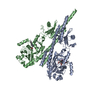 8u62MC 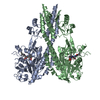 8u4xC 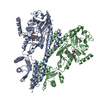 8u63C 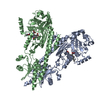 8u64C 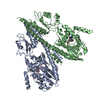 8u65C 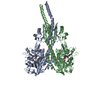 8u8zC M: atomic model generated by this map C: citing same article ( |
|---|---|
| Similar structure data | Similarity search - Function & homology  F&H Search F&H Search |
- Links
Links
| EMDB pages |  EMDB (EBI/PDBe) / EMDB (EBI/PDBe) /  EMDataResource EMDataResource |
|---|---|
| Related items in Molecule of the Month |
- Map
Map
| File |  Download / File: emd_41941.map.gz / Format: CCP4 / Size: 476.8 MB / Type: IMAGE STORED AS FLOATING POINT NUMBER (4 BYTES) Download / File: emd_41941.map.gz / Format: CCP4 / Size: 476.8 MB / Type: IMAGE STORED AS FLOATING POINT NUMBER (4 BYTES) | ||||||||||||||||||||||||||||||||||||
|---|---|---|---|---|---|---|---|---|---|---|---|---|---|---|---|---|---|---|---|---|---|---|---|---|---|---|---|---|---|---|---|---|---|---|---|---|---|
| Annotation | Dimer of Dimers of PsBphP in Pfr state, DeepEMhancer post-processed map | ||||||||||||||||||||||||||||||||||||
| Projections & slices | Image control
Images are generated by Spider. | ||||||||||||||||||||||||||||||||||||
| Voxel size | X=Y=Z: 0.657 Å | ||||||||||||||||||||||||||||||||||||
| Density |
| ||||||||||||||||||||||||||||||||||||
| Symmetry | Space group: 1 | ||||||||||||||||||||||||||||||||||||
| Details | EMDB XML:
|
-Supplemental data
-Additional map: Dimer of Dimers of PsBphP in Pfr state, unsharpened map
| File | emd_41941_additional_1.map | ||||||||||||
|---|---|---|---|---|---|---|---|---|---|---|---|---|---|
| Annotation | Dimer of Dimers of PsBphP in Pfr state, unsharpened map | ||||||||||||
| Projections & Slices |
| ||||||||||||
| Density Histograms |
-Half map: Dimer of Dimers of PsBphP in Pfr state, half-map #1
| File | emd_41941_half_map_1.map | ||||||||||||
|---|---|---|---|---|---|---|---|---|---|---|---|---|---|
| Annotation | Dimer of Dimers of PsBphP in Pfr state, half-map #1 | ||||||||||||
| Projections & Slices |
| ||||||||||||
| Density Histograms |
-Half map: Dimer of Dimers of PsBphP in Pfr state, half-map #2
| File | emd_41941_half_map_2.map | ||||||||||||
|---|---|---|---|---|---|---|---|---|---|---|---|---|---|
| Annotation | Dimer of Dimers of PsBphP in Pfr state, half-map #2 | ||||||||||||
| Projections & Slices |
| ||||||||||||
| Density Histograms |
- Sample components
Sample components
-Entire : PsBphP
| Entire | Name: PsBphP |
|---|---|
| Components |
|
-Supramolecule #1: PsBphP
| Supramolecule | Name: PsBphP / type: complex / ID: 1 / Parent: 0 / Macromolecule list: #1 |
|---|---|
| Source (natural) | Organism:  Pseudomonas syringae pv. tomato str. DC3000 (bacteria) Pseudomonas syringae pv. tomato str. DC3000 (bacteria) |
-Macromolecule #1: histidine kinase
| Macromolecule | Name: histidine kinase / type: protein_or_peptide / ID: 1 / Number of copies: 2 / Enantiomer: LEVO |
|---|---|
| Source (natural) | Organism:  Pseudomonas syringae pv. tomato str. DC3000 (bacteria) Pseudomonas syringae pv. tomato str. DC3000 (bacteria) |
| Molecular weight | Theoretical: 82.382555 KDa |
| Recombinant expression | Organism:  |
| Sequence | String: GMSQLDKDAF EVLLANCADE PIQFPGAIQP HGLLFTLKEP ELTILQVSAN VQSVLGKVPD QLAGQTLDCV LGAGWAEVIR STSANDSLV DVPRLLMSVE GVEFEALLHR SQEALVLELE IQDKAAQAIS YSERTGNMGR MLRQLHAAAD LQTLYEVSVR E IQRMTGYD ...String: GMSQLDKDAF EVLLANCADE PIQFPGAIQP HGLLFTLKEP ELTILQVSAN VQSVLGKVPD QLAGQTLDCV LGAGWAEVIR STSANDSLV DVPRLLMSVE GVEFEALLHR SQEALVLELE IQDKAAQAIS YSERTGNMGR MLRQLHAAAD LQTLYEVSVR E IQRMTGYD RVLIYRFEEE GHGQVIAEAS APAMELFNGL FFPASDIPEQ ARELYRRNWL RIIPDANYTP VPLVPQLRPD TQ QQLDLSF STLRSVSPIH CQYMKNMGVL SSMSVSLIQG GKLWGLISCG HRTPLYVSHE LRSACQAIGQ VLSLQISAME ALE VSRQRE TKIQTLQQLH QMMATSDTDV FDGLAQQPQL LMDLVGATGV AIIEDRQTHC YGNCPEPSDI RALHTWMMAG GEPV YASHH LSSVYPPGEA YQTLASGVLA MSLPKPVDNG VIWFRPEVKQ SVQWSGDPNK PLNLDASDNT LRLQPRTSFE IWKVE MTGI ATKWSHGDVF AANDLRRSAL ENDLARQVSK EQQAVRARDE LVAVVSHDLR NPMTVISMLC GMMQKSFSSD GPHTSR RIS TAIDTMQQAA SRMNVLLEDL LDTSKIEAGR YTITPQPLEV SQIFEEAYTL LAPLAMDKSI EISFNAEPDI KVNADPE RL FQVLSNLIGN AIKFTPKLGR IGVAAMSNGD EVVFTVRDSG EGIPPEQLPH IFERYWTVKE GNPTGTGLGL YISQGIIK A HGGELAAQSQ VGHGSEFRFT VPIAH UniProtKB: histidine kinase |
-Macromolecule #2: 3-[2-[(Z)-[3-(2-carboxyethyl)-5-[(Z)-(4-ethenyl-3-methyl-5-oxidan...
| Macromolecule | Name: 3-[2-[(Z)-[3-(2-carboxyethyl)-5-[(Z)-(4-ethenyl-3-methyl-5-oxidanylidene-pyrrol-2-ylidene)methyl]-4-methyl-pyrrol-1-ium -2-ylidene]methyl]-5-[(Z)-[(3E)-3-ethylidene-4-methyl-5-oxidanylidene- ...Name: 3-[2-[(Z)-[3-(2-carboxyethyl)-5-[(Z)-(4-ethenyl-3-methyl-5-oxidanylidene-pyrrol-2-ylidene)methyl]-4-methyl-pyrrol-1-ium -2-ylidene]methyl]-5-[(Z)-[(3E)-3-ethylidene-4-methyl-5-oxidanylidene-pyrrolidin-2-ylidene]methyl]-4-methyl-1H-pyrrol-3- yl]propanoic acid type: ligand / ID: 2 / Number of copies: 2 / Formula: LBV |
|---|---|
| Molecular weight | Theoretical: 585.67 Da |
-Experimental details
-Structure determination
| Method | cryo EM |
|---|---|
 Processing Processing | single particle reconstruction |
| Aggregation state | particle |
- Sample preparation
Sample preparation
| Concentration | 0.5 mg/mL |
|---|---|
| Buffer | pH: 7.5 |
| Vitrification | Cryogen name: ETHANE / Chamber humidity: 100 % / Chamber temperature: 277 K / Instrument: FEI VITROBOT MARK IV |
- Electron microscopy
Electron microscopy
| Microscope | FEI TITAN KRIOS |
|---|---|
| Temperature | Min: 82.0 K / Max: 84.0 K |
| Specialist optics | Spherical aberration corrector: Microscope is outfitted with a Cs image corrector with two hexapole elements. |
| Details | Preliminary grid screening was performed manually. |
| Image recording | Film or detector model: FEI FALCON IV (4k x 4k) / Digitization - Dimensions - Width: 4096 pixel / Digitization - Dimensions - Height: 4096 pixel / Number grids imaged: 3 / Number real images: 12593 / Average exposure time: 4.28 sec. / Average electron dose: 51.78 e/Å2 |
| Electron beam | Acceleration voltage: 300 kV / Electron source:  FIELD EMISSION GUN FIELD EMISSION GUN |
| Electron optics | C2 aperture diameter: 150.0 µm / Illumination mode: FLOOD BEAM / Imaging mode: BRIGHT FIELD / Cs: 0.01 mm / Nominal defocus max: 2.4 µm / Nominal defocus min: 1.0 µm / Nominal magnification: 96000 |
| Sample stage | Specimen holder model: FEI TITAN KRIOS AUTOGRID HOLDER / Cooling holder cryogen: NITROGEN |
| Experimental equipment |  Model: Titan Krios / Image courtesy: FEI Company |
 Movie
Movie Controller
Controller



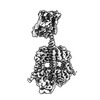








 Z (Sec.)
Z (Sec.) Y (Row.)
Y (Row.) X (Col.)
X (Col.)













































